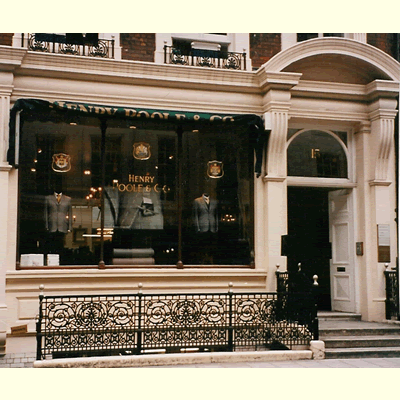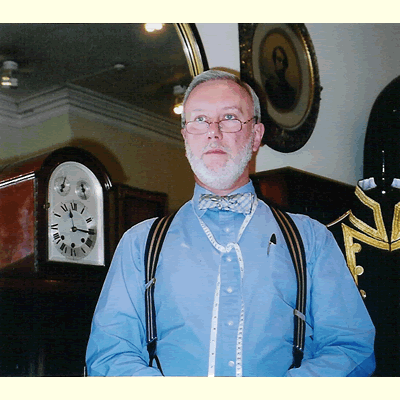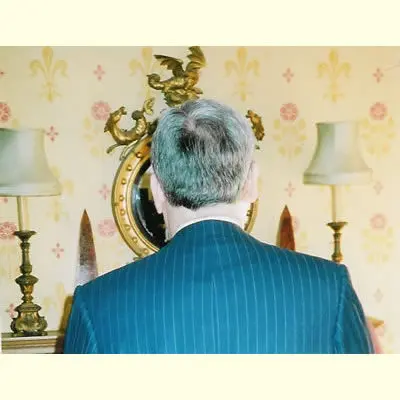


For the gentleman who cares about his appearance, the world offers no experience more pleasurable than that of taking a brisk walk from London’s Piccadilly to the entrance of number 15 Savile Row. Here resides the firm of Henry Poole and Company. Livery tailor to Her Majesty Queen Elizabeth II, by special appointment to the late Emperor of France, Napoleon III, and holder, in the two centuries of its existence, of no fewer than 40 royal warrants, this is the Savile Row tailor par excellence. Indeed, as it was Henry Poole himself who turned the name of this London street into a synonym for the finest bespoke tailoring on the planet, we can rightly regard Henry Poole & Co. as the fons et origo of the whole Savile Row experience.
The story begins in 1806, when James Poole, tailor, and his wife, Mary, travelled from Shropshire to seek their fortune in the capital city. Having worked steadily for 40 years, James died in the year famous for the Repeal of the Corn Laws, 1846. At this point Henry took over his father’s tailoring business and gave to it his own name. In the same year the move was made into Savile Row – where the firm remained until 1961. (After a twenty-year exile in nearby Cork Street, Henry Poole & Co. returned to the Row in that other excellent year for claret, 1982.) Henry was a brilliant tailor and a brilliant publicist. By the time of his death, in 1876, few in the tailoring world disputed the pre-eminence of Henry Poole. His sister and his cousin, Samuel Cundey, took over the firm.
Today the Cundeys are still in charge, for Henry Poole & Co. is the only Savile Row firm to have remained family-owned and family-managed since its beginnings. My picture shows Mr Angus Cundey, one of the present directors. Mr Cundey owns a vintage Frazer Nash motor car – the sort of vehicle which suggests a love of dash and excitement. I found him to be a most elegant and charming gentleman, whose modest courtesy sets the tone for the whole establishment.
That tone is one of the delights to be savoured when you become “In the Poole”. Another is the sense of taking part in an important living tradition. So many famous and notable folk have walked the world’s stage in Henry Poole clothes that it might be invidious to single out by name a particular emperor, prince, politician, writer or film star. But I cannot resist a mention of King Boris III of Bulgaria. In 1936 the good King found himself in London without benefit of evening tails, but with an invitation to dine at Buckingham Palace that very evening. What could he do? Why, call at Henry Poole, of course. Having been measured, His Majesty went for a walk in the park. When he returned, his tails were ready.
Nor does the history always include stitching. If you have ever wondered why the police station on the Row is not called – as logic might suggest – the Savile Row police station, it is because Henry Poole & Co. did not consider it proper for the name of the Row to be attached to premises used by the constabulary. A couple of years after King Boris went for his stroll, the firm led a successful campaign to change the name to what it is today – the West End Central police station. Quite right, say I.
The current premises, which date from 1887, are welcoming. In the front of the shop is an octagonal showcase of mahogany and brass, made in the 1860s for the display of hunt buttons. Further back, is a pair of jockey scales, acquired in 1875 after a dispute with a customer who denied having put on weight. In the basement, are leather-bound ledgers going back to the beginning of the firm’s history. Looking around, I loved this sense of the continuity of excellence.


And I loved, too, the prospect of selecting a cloth for my suit. Henry Poole always carries about 4,000 materials from which to choose. Surveying the rows of sample books, I wondered how long the search would take. About five minutes, as it turned out – for I had the assistance of one of the cutters, David Ward. Mr Ward must have an encyclopaedic knowledge of his cloths. I said to him that I was looking for a chalk stripe on petrol blue, of medium weight. He went straight to a book from Smith’s, of Huddersfield. He opened it and there was what I wanted – a super 100 of 10/11 ounces. He went on to produce several alternatives, but the original was the one for me.
Now Mr Ward began to inscribe the stylistic details of my suit. My jacket was be single-breasted, but with peak lapels. Its lining was to be red. Four buttons (of real horn) on each cuff, of course. The house style is to have 2 opening and 2 sham (to facilitate any future alterations), but I like all four to open – so my preference was noted. The trousers with two front pleats, straight side pockets, 18-inch turn-ups, a button fly and buttons for braces (the front outside, the back inside – to protect the leather of the Royce). And the stripes at all the joins to match, if possible. (This last is difficult to achieve, particularly over the shoulders and on the lapels.)
Next I was passed to Mr Alan Alexander, a gentleman from Essex who is one of the firm’s four senior cutters. Mr Alexander it was who took my measurements. He would now be ‘my cutter’ and he would be the man who would see me through my fittings – deciding upon all those many tiny adjustments which would turn a well-fitting suit into a superbly crafted bespoke suit. Mr Alexander – as you will note from the photograph – dresses well and often sports a bow tie.
Through the course of three fittings, he adjusted the hang and length of the sleeves, changed the width of the shoulders and of the jacket waist and increased the prominence of the lapels. He also raised the height of the trouser waist. As requested, the stripes ran smoothly across the seams. Many of the alterations were marginal, but Mr Alexander is a perfectionist in an establishment which values perfection, so he was clear that everything must be just-so.
And just-so it is. The fit of my suit, as I hope you can see, is quite remarkable; the cut is superb; and the workmanship is faultless. I could not be more pleased.
But what of the cost? In 1858, in The Art of Training Horses, the writer observed that Henry Poole supplied “more men and masters of hounds than any tailor, but his customers must be prepared to pay for perfection”. Now, that perfection costs from around £2,300 (including V.A.T.) for a two-piece suit and from around £2,400 for a three-piece suit. When one considers the dedicated work and skill which goes into these garments (and looks at the cost of some of the shapeless, ready-made ‘designer’ suits on offer elsewhere), these prices must be considered admirably modest.
Certainly, bespoke tailoring for the gentleman does not come any better than at Henry Poole & Co. The walk to number 15 Savile Row is a pleasure you should deny yourself no longer.
HENRY POOLE & CO
15 Savile Row, London W1S 3PJ, England.
Telephone +44 (0)207 734 5985
Fax +44 (0)207 287 2161
Email: office@henrypoole.com
henrypoole.com
The firm’s cutters make regular tours of Europe and the United States. Ask for details